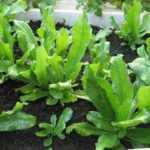Cabbage is not only packed with nutritional value but is also incredibly easy to grow. If you’re looking for a vegetable to cultivate in your garden, give this one a go – you won’t be disappointed!
1 What You’ll Need
- Polystyrene box
- Soil
- Fertilizer
- Cabbage seeds
- Watering can with a nozzle, weeding tools
 Cabbage seeds
Cabbage seeds
Note
For soil, opt for regular field soil, alluvial soil, or a mix of husk, coconut coir, and organic fertilizer to create a nutrient-rich growing medium.
As for seeds, source high-quality ones from reputable seed distributors to ensure a high germination rate and healthy growth.
2 How to Grow Cabbage
Step 1 Prepare the Soil
 Prepare the soil a week before sowing
Prepare the soil a week before sowing
Prepare the soil a week before sowing. You can mix it with rice husk ash, coconut coir, and organic fertilizer… Then, loosen the soil and sun-dry it to kill any pathogens.
If you have a large area to plant, create raised beds about 10-15cm high and sprinkle lime powder on them. For polystyrene box gardening, simply level the soil.
Step 2 Sow the Seeds
 Sowing seeds
Sowing seeds
To speed up germination, soak the seeds in warm water (30-40°C) for 3-6 hours before sowing. Then, drain and sow.
Sow the seeds evenly across the soil, adjusting the quantity to your planting area. Overcrowding inhibits growth, but too much space leaves plants vulnerable to pests.
Lightly cover the seeds with a thin layer of ash or husk.
Step 3 Watering
 Use a nozzle can to water
Use a nozzle can to water
Water daily with a nozzle can, taking care not to overwater and cause soil erosion. Ensure your polystyrene box is placed in a sunny spot for photosynthesis.
Step 4 Cover with Straw
 Cover the soil with straw
Cover the soil with straw
To encourage germination, cover the soil with a cloth or straw for 5-7 days.
3 Caring for Your Cabbage
Water your cabbage daily, in the morning and evening.
A week after sowing, fertilize your plants with easily accessible organic options like manure, cow dung, or chicken droppings…
 Young cabbage plants
Young cabbage plants
Once the seeds have sprouted, thin out the seedlings by transplanting some into another polystyrene box. This gives the remaining plants room to grow.
Keep an eye out for pests and, if spotted, buy herbal solutions from agricultural stores, dilute them with water, and spray your plants 2-3 times, with a 2-day interval between each application.
Harvest time: After about a month, your cabbage will be ready to harvest. Don’t leave it too long, or it will become bitter and unpalatable.
 Harvesting cabbage
Harvesting cabbage
Homegrown cabbage can be turned into a variety of delicious and nutritious dishes for your family, such as , , ,…
We hope these tips help you grow healthy cabbage. Good luck!



































